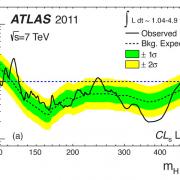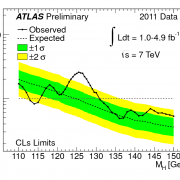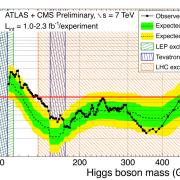Access to Collaboration Site and Physics Results

The ATLAS Collaboration at CERN has released new studies of the Higgs boson using 13 TeV data collected in 2015 and 2016. The results further corroborate the Standard Model nature of the Higgs boson, and open doors to fresh searches for new physics.
“ATLAS is moving beyond the more straightforward Higgs boson analyses,” says ATLAS Higgs working group convenor, Fabio Cerutti. “The abundance of Run 2 data has allowed us to study the Higgs boson in rare and experimentally challenging interactions, and examine its properties with improved precision. Not only are we learning more about the Standard Model, we are challenging the limits of the theory, providing measurements of comparable precision.”
Precision, Precision, Precision
At the recent Rencontres de Moriond on Electroweak Interactions, ATLAS released a new study of the Higgs decay to two W bosons, providing improved measurements of Higgs properties. ATLAS has also published a new analysis of the Higgs decay to two photons, improving the precision of this channel by a factor of two with respect to previous measurements. This precision was further improved by combining the two most precise Higgs decay channels to two photons and four leptons.
“Where once we were looking for a hint of a signal over background, we are now beginning to probe theoretical predictions and observe hidden characteristics of the Higgs,” says Kerstin Tackmann, ATLAS Higgs working group convenor. “We can study things like the dependency of a particle’s production on the transverse momentum of the Higgs boson – something we could not see with this precision before. Such characteristics are very interesting in and of themselves.”
ATLAS physicists are also searching for signs of new physics in previously unexplored “kinematic regions” of well-understood decays. For example, they are not only looking for photons originating from a Higgs boson, but specifically those produced by the decay of a high transverse momentum Higgs boson. “If a heavy new particle enters the production of the Higgs via gluon fusion, this could be seen as a modification of the high momentum decays,” explains Tackmann. “More data will allow us to improve our ability to search this kinematic region.”
"Not only are we learning more about the Standard Model, we are challenging the limits of the theory, providing measurements of comparable precision."
Discovery in the fermionic frontier
In 2016, both ATLAS and CMS observed the Higgs decay to a pair of tau leptons using Run 1 data. This landmark result was the first direct indication that the Higgs was responsible for the mass of fermions: a group of elementary particles that include six quarks and six leptons, divided into three “generations”. However much of the fermionic sector remained unexplored in Run 1. What about quarks? Or second generation leptons, such as muons? Would the Higgs boson be observed interacting with these particle in Run 2?
“Using 13 TeV data, ATLAS has been able to measure processes that involve the heaviest quark generation interacting with the Higgs, and have found them to be in agreement with Standard Model predictions,” says Cerutti. “ATLAS published the first evidence of the Higgs decay to b-quark pairs and the Higgs coupling to the top quark.”
Both interactions were difficult to measure – but for very different reasons. Billions of b-quarks are produced in the ATLAS detector, most from interactions unrelated to the Higgs. ATLAS physicists spent years perfecting a method to pick out the Higgs signal from this dominant background, selecting events where the Higgs is produced in association with a Z or a W boson. On the other hand, the rare “ttH” production process makes up only 1% of the total Higgs production rate! By looking across several different Higgs decay modes, ATLAS physicists were able to combine their results to give strong evidence of this production.
More data, more answers, more questions
“There are still many interesting things we have yet to uncover,” concludes Cerutti. “With more data, we hope to observe the Higgs interacting with muons. Such a result could help us understand why fermions have the strange mass pattern they do. Does this come from the Higgs mechanism of electroweak symmetry breaking? Could there be an additional Higgs or another mechanism? We don’t yet know.”
With the LHC now entering its final year of Run 2, ATLAS physicists are looking forward to analyses of the entire 13 TeV dataset. Will future measurements continue to agree with the Standard Model? Could observed deviations lead to discovery? Stay tuned, as the exploration of the Higgs boson continues.
To learn more about the results discussed in this article, check out the following ATLAS Physics Briefings:
- ATLAS illuminates the Higgs boson at 13 TeV: new study of Higgs boson decaying into two photons, 26 March 2018
- The exploration of the Higgs boson continues: ATLAS presents a new study of the Higgs boson decaying to two W bosons, 12 March 2018
- ATLAS finds evidence of the Higgs boson produced in association with a pair of top quarks, 26 October 2017
- Exploring rare decays of the Higgs boson, 11 August 2017
- A first LHC sighting of the Higgs boson in its favourite decay: to a pair of b-quarks, 6 July 2017
- See also the full lists of ATLAS Conference Notes and ATLAS Physics Papers.



.jpg%3Fitok=2BuBi0cC)




